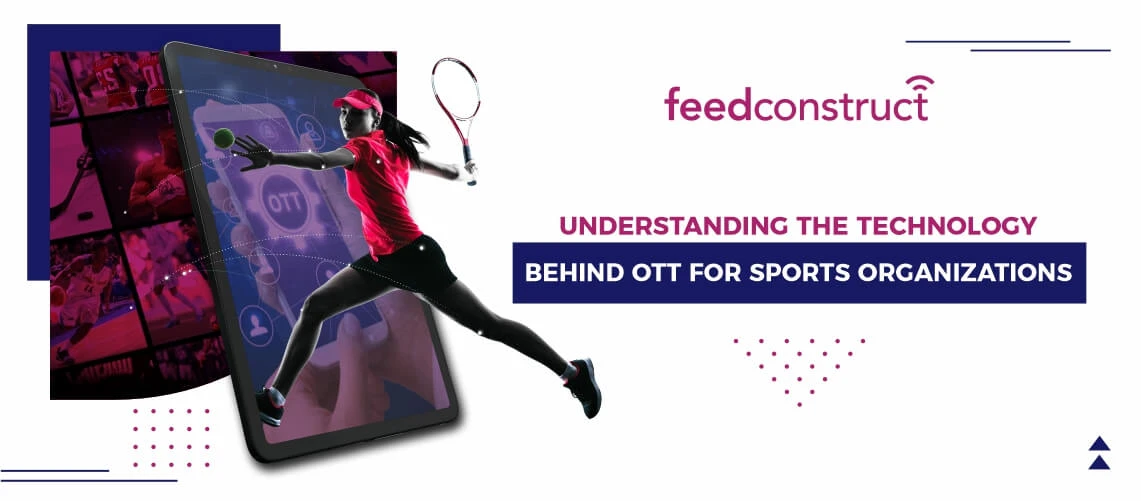In recent years, over-the-top (OTT) streaming technology has revolutionised the way sports organisations broadcast their events. With this technology, sports organisations can reach a wider audience, personalise their content, and enhance fan engagement.
The history of OTT sports services dates back to the early 2000s when companies such as WWE began experimenting with streaming live sports events. Since then, OTT sports services have grown in popularity and are now used by sports organisations of all sizes to deliver content to fans around the world.
In this article, we will explore the technology behind OTT and its benefits for sports organisations.
What is OTT Technology?
OTT technology allows media content to be delivered over the Internet without the need for traditional cable or satellite TV subscriptions. This technology enables viewers to access content on any device with an internet connection, such as smartphones, tablets, and smart TVs.
OTT technology has also made it possible for sports organisations to provide a personalised viewing experience to their fans. By leveraging OTT video personalisation solutions, sports organisations can deliver customised content to viewers based on their preferences, viewing habits, and location.
Overview of the Technology Behind OTT
OTT streaming is heavily reliant on a combination of technologies that enable the distribution of content over the internet. Among these technologies are CDNs, which facilitate the efficient delivery of content to viewers, encoding and transcoding, which convert and compress media files to optimise their quality and size for streaming; and DRM, which ensures the protection of copyrighted content from unauthorised access or distribution.
Understanding the functions of these technologies is essential to comprehend how OTT streaming works and how it provides seamless access to high-quality content. Therefore, let's delve into these technologies and examine their roles in the OTT streaming ecosystem.
Content Delivery Networks (CDNs)
Content Delivery Networks, or CDNs for short, have become an essential component of the modern internet landscape. With the ever-increasing demand for high-quality digital content, CDNs have emerged as a powerful solution to help alleviate the challenges of content delivery. By leveraging a distributed network of servers located in different geographic regions, CDNs can effectively improve website performance, resulting in a more satisfying user experience.
Additionally, CDNs can also provide added security benefits by serving as a buffer between a website's origin server and potential attackers, helping to mitigate DDoS attacks and other types of cyber threats.
How CDNs Work for OTT
CDNs are essential for OTT platforms to deliver high-quality content. CDNs cache frequently accessed content on local servers, reducing latency and improving playback quality by delivering content from the server closest to the user. CDNs also provide scalability and reliability by distributing content across multiple servers, balancing the load and preventing server overload. In case of a server failure, CDNs can redirect traffic to other servers, ensuring uninterrupted viewing for users.
Encoding and Transcoding
In the world of digital media, encoding and transcoding play a crucial role in ensuring that content is delivered efficiently and effectively across a wide range of devices and platforms. Encoding is compressing raw video and audio files into a more compact format, such as MP4 or H.264 while maintaining the quality of the content. Transcoding, on the other hand, involves taking an already compressed video and audio file and converting it into different formats, resolutions, and bitrates, depending on the needs of the viewer and the device being used.
For example, a video originally encoded in 1080p HD may need to be transcoded to 720p or even lower to ensure smooth playback on a mobile device with a slower internet connection.
How Encoding and Transcoding Work for OTT
In order to ensure that viewers can access content on a variety of devices, OTT providers rely on a combination of encoding and transcoding technologies, as well as content delivery networks (CDNs). Encoding and transcoding technologies work together with CDNs to deliver content in the most appropriate format for each device. CDNs use adaptive streaming to detect the viewer's device and adjust the video quality and format accordingly. This means that whether a viewer is accessing content on a mobile device or a desktop computer, they will receive the best possible viewing experience. By leveraging these technologies, sports organisations can ensure their content is accessible to viewers on a wide range of devices, increasing engagement and viewership.
Digital Rights Management
Digital Rights Management (DRM) technology protects content from unauthorised access and distribution. DRM ensures that content is only accessible to authorised viewers and prevents unauthorised copying, sharing, or distribution.
DRM technology applies encryption to content, making it inaccessible to unauthorised viewers. When viewers request access to content, the DRM system verifies their identity and ensures they have the appropriate permissions to access the content. This prevents unauthorised access and protects the content from piracy.
How DRM Works for OTT
DRM technology is integrated with the OTT streaming platform, providing content owners with complete control over who can access their content. Content owners can set permissions for individual users, allowing them to watch the content on specific devices and at specific times. This ensures that the content is protected from piracy and that content owners can monetise their content effectively.
Benefits of DRM for Sports Organizations
DRM technology is particularly useful for sports organisations that generate revenue from broadcasting their events. By implementing DRM, sports organisations can prevent piracy, ensuring that their content is only accessible to legitimate viewers who have paid for the rights to access it. This not only protects the financial interests of the organisation but also helps to maintain the value of its content by preventing unauthorised distribution and reproduction.
In addition, DRM technology can also provide sports organisations with valuable insights into the viewing habits of their audience, allowing them to understand their preferences better and tailor their content accordingly. This can help to drive engagement and increase the overall value of the organisation's brand.
What Is Cloud-Based OTT?
Cloud-based OTT refers to the delivery of OTT content using cloud-based infrastructure. With cloud-based OTT, content is stored and delivered from the cloud, allowing sports organisations to scale their operations quickly and efficiently. This eliminates the need for expensive hardware and infrastructure, allowing sports organisations to focus on delivering high-quality content to their viewers.
How Cloud-Based Works for OTT
Cloud-based OTT relies on cloud-based infrastructure, which includes cloud storage, cloud computing, and cloud networking. Cloud storage enables content to be stored in the cloud, while cloud computing allows for the encoding, transcoding, and delivery of content. Cloud networking ensures that the content is delivered securely and efficiently to viewers. Overall, cloud-based OTT is an innovative solution that helps sports organisations deliver high-quality content to their viewers while minimising the cost and complexity of traditional delivery methods.
Final Words on OTT Technology
OTT technology has revolutionised the way sports organisations deliver content to their viewers. With OTT, sports organisations can reach a wider audience, personalise their content, and enhance fan engagement. By leveraging technologies such as CDNs, encoding and transcoding, and DRM, sports organisations can deliver high-quality content to viewers across a range of devices.
If you're interested in live-streaming sporting events, there are several key steps to consider. First, you'll need to select a streaming platform that meets your needs and budget. Next, you'll need to acquire the necessary equipment and software to capture and stream your content. Finally, you'll need to test and optimise your stream to ensure it is reliable and delivers high-quality video to your viewers.
FAQ
What are some challenges associated with implementing and maintaining an OTT platform?
Implementing and maintaining an Over-The-Top (OTT) platform comes with several challenges. One of the main challenges is the need for a robust infrastructure that can handle high traffic volume and deliver content seamlessly to users across various devices and locations. Another challenge is negotiating and securing rights to distribute content from studios, networks, and other content providers. Additionally, OTT platforms need to continually innovate and improve their user experience to attract and retain viewers while also ensuring data privacy and security.
What is streaming technology, and how does it work for OTT?
Streaming technology delivers media content over the internet in real time, allowing users to access and consume the content without downloading it first. OTT platforms use streaming to deliver video and audio content to users across devices. The technology streams the content in small packets and adjusts quality based on internet speed and device capabilities for smooth playback.






